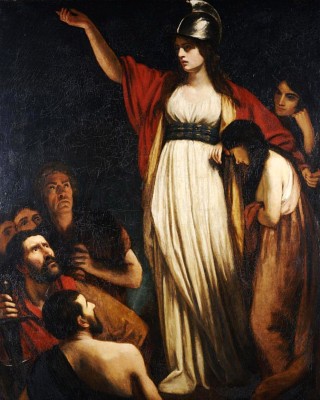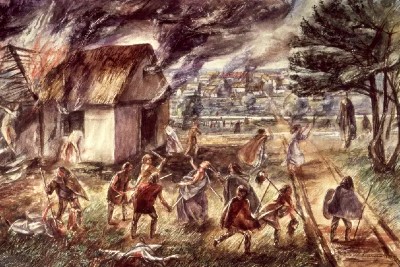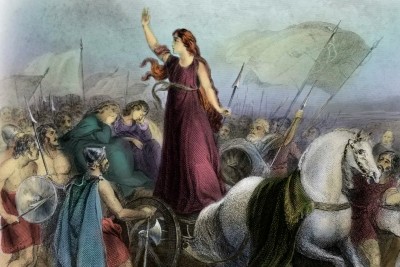How Attitudes to Women’s Rights Caused Queen Boudicca to Revolt

Queen Boudicca (also known as Boudica, Boadicea, Boudicea and Buddug), is a well-known figure in women’s history, famed for leading a bloody revolt against the Romans. Her reasons for doing this were twofold, to gain freedom for her people and to exact revenge for the mistreatment of her and her family.
Despite her fame, very little is known about her for sure and what we do know comes from the writings of two Romans, Tacitus and Cassius Dio, and from what little archaeological evidence is available.


The Coming of the Roman Invaders – 43 CE
Boudicca (depicted here in a painting by John Opie (1761–1807) called Boadicea Haranguing the Britons), was the wife of the chieftain Prasutagus, ruler of a tribe called the Iceni who were situated in East Anglia in Southern Britain. Their location was relatively isolated as it was largely surrounded by forest and the sea but that did not stop the Roman invaders from being a threat to them. When the Romans came in 43 CE, they swept across the east of the country conquering any tribe that would not pledge allegiance to them.
Like many local chieftains, Prasutagus decided that the future of his tribe lay not with fighting the vastly more powerful foreign invaders but in joining them. He paid homage to the Roman Emperor and became a client king, ruling in the name of Rome and answering to the Emperor and the Governor of Britain.
Culture Clash – Differing Attitudes to Women’s Rights in Society
When he died around 60 – 61 CE, Prasutagus left his kingdom jointly to his two daughters and the new Emperor of Rome, Nero. Aristocratic women in Celtic society were in a position of prestige and power, and when it came to women's rights, they were way ahead of their time. Women were allowed to be active participants in political, religious and artistic pursuits, and they could own land, marry whom they chose and even initiate divorce.
However, under Roman law things were very different and the largest empire the world had ever seen had little to offer when it came to the rights of their women. The idea of co-owning the kingdom in itself would have been unacceptable to Nero and on top of this, daughters did not have inheritance rights. In fact, they found the very idea of women being involved in leadership and politics offensive and saw it as evidence of Celtic barbarity.
To make an example of the Iceni for such an insult, members of the Royal Family were enslaved and Queen Boudicca was herself stripped and flogged. Then, in an act that can only be described as despicable, the Iceni leader was made to watch as her two daughters were publicly raped and tortured; the girls are believed to have been around the age of twelve at the time of their ordeal.
Queen Boudicca and War with the Romans
Queen Boudicca and the Iceni were not the only ones to suffer at the hands of the Roman invaders and even collaborators were being harshly treated and heavily taxed. As a result, many neighbouring tribes joined her when she began a rebellion that was designed to rid the Island of this foreign force for good. Anti-Roman sentiment, it seems, was high, so much so that the usually fragmented tribes flocked to her cause with as many as one hundred thousand warriors turning out to fight the Romans initially.

The revolt began with attacks on the Roman capital city of Camulodunum (Colchester) where the Ninth Legion were defeated. They then went on to defeat the Romans at Verulamium (St Albans) and the growing town of Londinium (London) (depicted above), while the Roman Governor of Britain,
Gaius Suetonius Paullinus was busy leading a campaign against non-collaborating tribes in North Wales.
Cassius Dio gives a description of the Queen of the Iceni, stating:
She was huge of frame, terrifying of aspect, and with a harsh voice. A great mass of bright red hair fell to her knees: She wore a great twisted golden necklace, and a tunic of many colours, over which was a thick mantle, fastened by a brooch. Now she grasped a spear, to strike fear into all who watched her...
Celtic soldiers painted themselves with blue paint in a bid to make themselves look more frightening to their enemies which must have been effective because they managed to kill thousands of Roman soldiers during the revolt. However, Queen Boudicca’s armies were finally defeated at the Battle of Watling Street.
The Roman force of ten thousand men was heavily outnumbered, with an estimated two hundred and thirty thousand Celts lining up to fight them.
The Romans were tactically superior however and advanced towards their foe in a wedge-shaped formation, throwing Javelins to pick off the advancing Celtic warriors along with deploying their cavalry. The Britons were slaughtered and according to Tacitus, not even the animals were spared.
Dio states that Queen Boudicca fell sick and died soon after the Battle of Watling Street, though Tacitus states that she poised herself and was given a lavish burial when she passed away.
The Romans would go on to occupy Britain for the next three hundred and fifty years but despite this, the legacy of Queen Boudicca lives on. The fact that a band of barbaric tribes led by a woman caused so much injury and death, and came close to defeating the mighty Roman army would have shaken the Empire to the core and it can be argued that it also struck an early blow for women’s rights that would not be soon forgotten.

Written by Andrew Griffiths – Last updated 09/05/2023. Please visit my Sample Page or go to my passion project, The History of Fighting, for more examples of my writing.
To get history articles like this on your site, please feel free to contact me for a consultation.
References:
Boudica's Revolt. [Internet]. 2012. Spartacus Education: Available from: http://www.spartacus.schoolnet.co.uk/ROMboudicca.htm [Accessed on 19 Jan 2012].
Boudicca. [Internet]. 2010. University of North Carolina. Available from: http://www.unc.edu/celtic/catalogue/boudica/catalog.html [Accessed 18 Jan 2012].
Boudicca (died c.AD 60). [Internet]. 2012. BBC. Available from: http://www.bbc.co.uk/history/historic_figures/boudicca.shtml [Accessed on 19 Jan 2012].
British Archaeology News. [Internet]. 2003. British Archaeology Magazine. Available from: http://www.britarch.ac.uk/ba/ba70/news.shtml#item1 [Accessed 18 Jan 2012].
Indi Bains. [Internet]. 2023. 11 Facts About Boudica, Warrior Queen of the Iceni. Available from: https://www.mentalfloss.com/posts/boudica-warrior-queen-iceni-facts [Accessed 09/05/2023].
London Graves Desecrated by Boudicca's Army. [Internet]. 2010. Council for British Archaeology. Available from: http://www.britarch.ac.uk/ba/ba83/feat3.shtml [Accessed 19 Jan 2012].
Queen Boudicca Quote
I am not fighting for my kingdom and wealth. I am fighting as an ordinary person for my lost freedom...Consider how many of you are fighting, and why.
Then you will win this battle, or perish. That is what I, a woman, plan to do! Let the men live in slavery if they will.
~ Queen Boudicca ~
